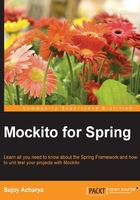
Conventions
In this book, you will find a number of styles of text that distinguish between different kinds of information. Here are some examples of these styles, and an explanation of their meaning.
Code words in text, database table names, folder names, filenames, file extensions, pathnames, dummy URLs, user input, and Twitter handles are shown as follows: "The messaging module comes with key abstractions from the Spring Integration project such as Message, MessageChannel, and MessageHandler to serve as a foundation for messaging-based applications."
A block of code is set as follows:
@Test
public void currencyRoundsOff() throws Exception {
assertNotNull(CurrencyFormatter.format(100.999));
assertTrue(CurrencyFormatter.format(100.999).
contains("$"));
assertEquals("$101.00", CurrencyFormatter.format(100.999));
}
When we wish to draw your attention to a particular part of a code block, the relevant lines or items are set in bold:
public class LocaleTest {
private Locale defaultLocale;
@Before
public void setUp() {
defaultLocale = Locale.getDefault();
Locale.setDefault(Locale.GERMANY);
}
@After
public void restore() {
Locale.setDefault(defaultLocale);
}
@Test
public void currencyRoundsOff() throws Exception {
assertEquals("$101.00", CurrencyFormatter.format(100.999));
}
}
New terms and important words are shown in bold. Words that you see on the screen, in menus or dialog boxes for example, appear in the text like this: "Right-click on the project; a pop-up menu will appear. Expand the Build Path menu and click on the Configure Build Path menu item."